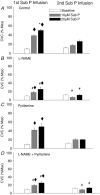Neurokinin-1 receptor desensitization to consecutive microdialysis infusions of substance P in human skin
- PMID: 16123103
- PMCID: PMC1464169
- DOI: 10.1113/jphysiol.2005.095372
Neurokinin-1 receptor desensitization to consecutive microdialysis infusions of substance P in human skin
Abstract
The neuropeptide substance P is known to be localized in nerve terminals in human skin and substance P-induced vasodilatation is believed to be partially dependent on nitric oxide (NO) and H1 histamine receptor activation. Unlike other neuropeptides investigated in human skin, substance P-induced vasodilatation has been shown to decline during continuous infusion, possibly suggestive of an internalization of neurokinin-1 (NK1) receptors, which are highly specific to substance P. However, questions remain regarding these mechanisms in human skin. Fifteen subjects participated in this series of studies designed to investigate the effect of consecutive infusions and possible mechanisms of substance P-induced vasodilatation in human skin. Two concentrations of substance P (10 microm and 20 microm) were tested via intradermal microdialysis in two groups of subjects. Site 1 served as a control and received substance P only. Site 2 received substance P combined with 10 mm L-NAME to inhibit NO synthase. Site 3 received substance P combined with 500 microm pyrilamine, an H1 receptor antagonist. Site 4 received substance P combined with 10 mm L-NAME plus 500 microm pyrilamine. Red blood cell (RBC) flux was measured via laser-Doppler flowmetry to provide an index of skin blood flow. Cutaneous vascular conductance was calculated as RBC flux/mean arterial pressure and was normalized to maximal vasodilatation via 28 mm sodium nitroprusside. Substance P was perfused through each microdialysis fibre at a rate of 4 microl min(-1) for 15 min. The subsequent increase in skin blood flow was allowed to return to baseline (approximately 45-60 min) and a stable 5 min plateau was used as a new baseline (post-infusion baseline). A second dose of substance P was then delivered to the skin and skin blood flow was monitored for 45-60 min. Substance P produced a dose-dependent increase in skin blood flow with the concentrations of substance P tested, which was significantly attenuated in the presence of L-NAME and the combination of L-NAME plus pyrilamine. However, substance P-induced vasodilatation was unaffected in the presence of pyrilamine. There was no significant difference between the L-NAME-only sites and the L-NAME plus pyrilamine sites. Importantly, the second dose of substance P did not produce a significant increase in skin blood flow compared to the initial baseline or the post-infusion baseline. These data suggest substance P-induced vasodilatation delivered via microdialysis contains an NO component but does not contain an H1 receptor activation component at the doses tested. Additionally, these data provide evidence for NK1 receptor desensitization as there was no observable increase in skin blood flow following a second administration of substance P. This may provide a useful model for studying the role of substance P in the control of skin blood flow in humans.
Figures



References
-
- Bennett VJ, Perrine SA, Simmons MA. Neurokinin-1 receptor resensitization precedes receptor recycling. J Pharmacol Exp Ther. 2005;313:1347–1354. - PubMed
-
- Boolell M, Tooke JE. The skin hyperemic response to local injection of substance P and capsaicin in diabetes mellitus. Diabetic Med. 1990;7:898–901. - PubMed
-
- Brown NJ, Roberts LJ. Histamine, bradykinin, and their antagonists. In: Hardman JG, Limbird LE, editors. Goodman and Gilman's the Pharmacological Basis of Therapeutics. 10th edn. New York: McGraw-Hill; 2001. pp. 645–667.
Publication types
MeSH terms
Substances
Grants and funding
LinkOut - more resources
Full Text Sources
Miscellaneous

